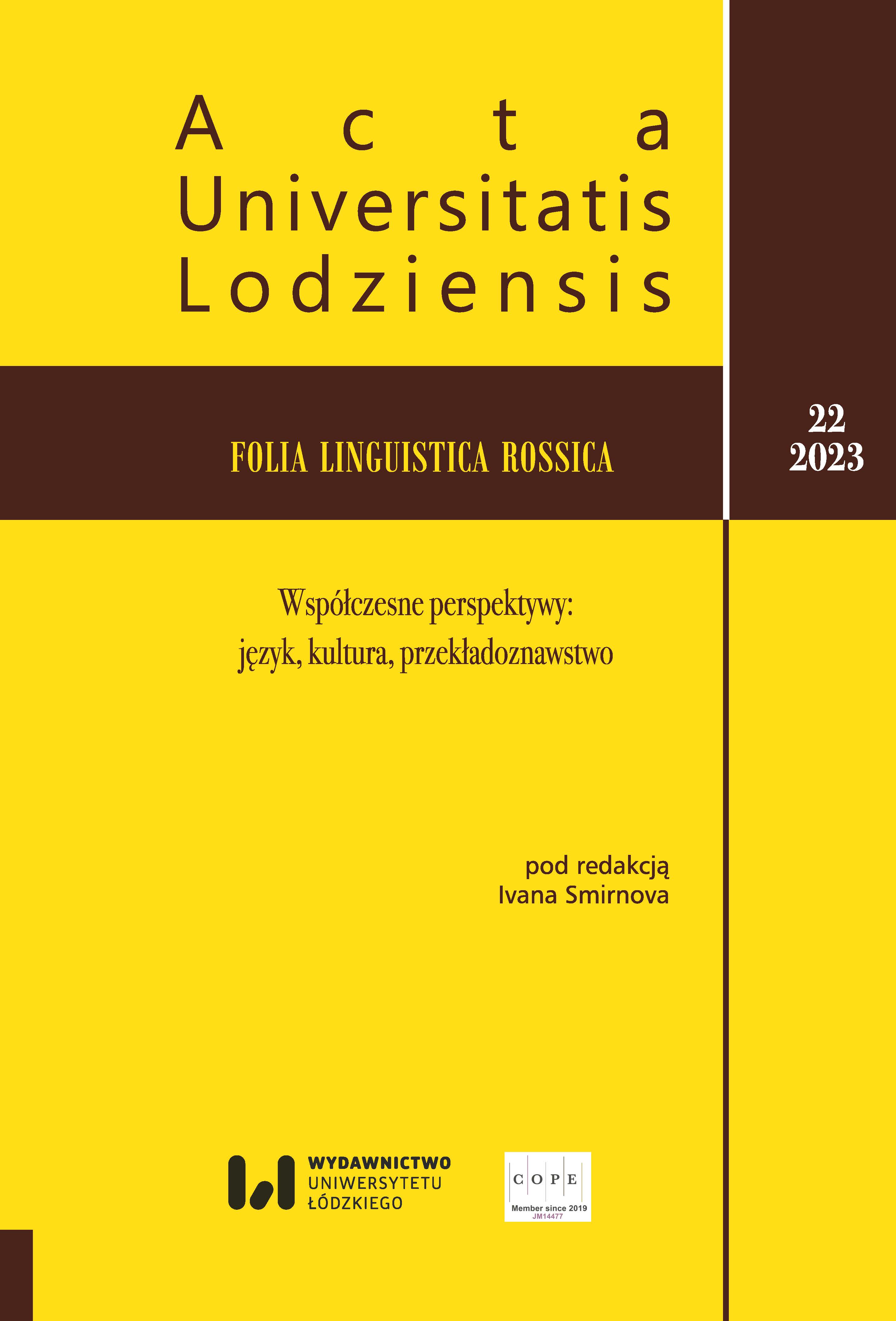The Psychological Symbolism of Dreams in the Work of F.M. Dostoevsky
DOI:
https://doi.org/10.18778/1731-8025.22.14Keywords:
Russian classical literature, Dostoevsky, Crime and Punishment, dreams, psychology, psychological interpretation of dreamsAbstract
The article analyses the phenomenon of dreams in literary texts, specifically in the works of Fyodor Mikhailovich Dostoevsky, a master of depicting human psychology. Dostoevsky belongs to the authors of the Golden Age of Russian literature and is considered one of the most important representatives of Russian and world literature.
Dreams have accompanied humans since ancient times, making it intriguing to explore their significance not only from a psychological perspective but also within the realm of literary interpretations. Through literary texts, we can grasp the symbolism and meaning of dreams and analyze their prevalence in each context.
In the novel Crime and Punishment (1866), there are five distinct dreams. The first two dreams are dreamt by the novel’s protagonist shortly before committing the crime, the next two dreams occur after the crime, and the last dream takes place during his forced labour in Siberia. For this analysis, the second dream was chosen, and the interpretation is based on the theoretical foundations of dream symbolism, especially drawing from the theories of Swiss psychologist and psychiatrist C.G. Jung (archetypal images) and American psychologist J. Hillman (mythological images).
Through this analysis, the article aims to interpret the possible psychological symbolism of Rodion Raskolnikov’s dream, discern its meaning, and explicitly and implicitly identify the dream’s symbols. The goal of the article is to explore the (psychological) significance of dreams as a subconscious construct of a literary character.
References
Авакумов, С.В. (2023). Психология сновидения, доступ: 9.04.2023.
Google Scholar
Берестнев, Г.И. (2023). Сонник Г.Х. Миллера: Структурное своеобразие и когнитивные модели толкования, https://cyberleninka.ru/article/n/sonnik-g-h-millera-strukturnoe-svoeobrazie-i-kognitivnye-modeli-tolkovaniya/viewer доступ: 9.04.2023.
Google Scholar
Васильева, И. (2023). Особенности метафор в «пророческих» сновидениях, https://cyberleninka.ru/article/n/osobennosti-metafor-v-prorocheskih-snovideniya/viewer доступ: 9.04.2023.
Google Scholar
Достоевский, Ф.М. (1994). Преступление и наказание. Paris: Bookking International.
Google Scholar
Lekeš, P. (2022). Вопросы самоубийства в произведении Достоевского «Кроткая»: (психологический подход). Slavica Litteraria, 25, 85–94.
Google Scholar
American Sleep Association (2022). Dreams: What They Mean & Psychology Behind Them, American Sleep Association, https://www.sleepassociation.org/about-sleep/dreams/ accessed: 12.03.2022.
Google Scholar
Antoš, M., Červeňák, A. (1980). Ruská literatúra XIX. storočia. Bratislava: Slovenské pedagogické nakladateľstvo.
Google Scholar
Avakumov, S.V. (2023). Psikhologiya snovideniya, accessed: 9.04.2023.
Google Scholar
Berestnev, G.I. (2023). Sonnik G.Kh. Millera: Strukturnoe svoeobrazie i kognitivnye modeli tolkovaniya, https://cyberleninka.ru/article/n/sonnik-g-h-millera-strukturnoe-svoeobrazie-i-kognitivnye-modeli-tolkovaniya/viewer accessed: 9.04.2023.
Google Scholar
Breger, L. (2019). Dostojevskij: Autor ako psychoanalytik, překlad B. Al Zafari. Bratislava: Nakladatel’stvo F, Pro mente sana.
Google Scholar
Bright, B. (2013). Working with Dreams: Depth Psychology Techniques of Carl Gustav Jung and James Hillman, Depthinsights, https://www.depthinsights.com/blog/working-with-dreams-depth-psychology-techniques-of-carl-gustav-jung-and-james-hillman/?fbclid=IwAR21J516Wlz5pGs5cfT4U7FUjvcoVvpNLxQEDz0rArjNGqsMGcbIel05T8o accessed: 8.04.2023.
Google Scholar
Červeňák, A. (1999). Dostojevského sny. Pezinok: Fischer & TypoSet.
Google Scholar
Červeňák, A. (1999). Tajomstvo Dostojevského: F.M. Dostojevskij v recepcii. Nitra: Pedagogická fakulta v Nitre.
Google Scholar
Červeňák, A. (2008). Reflexie esteticko-antropologické. Nitra: FF UKF Nitra.
Google Scholar
Dostoevskii, F.M. (1994). Prestuplenie i nakazanie. Paris: Bookking International.
Google Scholar
Fábik, D. (2023). Čo je sen?: Odpovedá Freud, Jung, Solms a ďalší…, https://www.bratislavapsycholog.sk/co-je-sen/ accessed: 27.01.2023.
Google Scholar
Hartmann, E. (2013). Sny. Trenčín: Nakladatel’stvo F, Pro mente sana.
Google Scholar
Heretik, A., Marsalová Heretiková, A. (2020). Sny: Využitie v psychoterapii a osobnostnom raste. Bratislava IKAR, a.s.
Google Scholar
Hillman, J. (1999). Sny a podsvětí. Praha: Portál, s.r.o.
Google Scholar
Hillman, J., Shamdasani, S. (2014). Nářek mrtvých, O. Fafejta (překlad). Praha: Portál, s.r.o.
Google Scholar
Hlbinná psychológia, Centrum spoločných činností Slovenskej akadémie vied, Encyklopedický ústav, https://beliana.sav.sk/heslo/hlbinna-psychologia?fbclid=IwAR0bxv5oxLwt63CpSb-JrQHgUgMl_OshTXqkaIzKibGdCv6XqeGO5pFtO-w accessed: 7.04.2023.
Google Scholar
Jacobi, J. (2013). Psychologie C.G. Junga, L. Menšíková, J. Kocourek, Z. Jančařík (překlad). Praha: Portál, s.r.o.
Google Scholar
Jeffé, A. (2015). Vzpomínky/ Sny/ Myšlenky C.G. Junga. Praha: Portál, s.r.o.
Google Scholar
Jung, C.G. (2017). Člověk a jeho symboly. Praha: Portál, s.r.o.
Google Scholar
Mangual, W. (2023). Descent into the Underworld: James Hillman’s Dreamwork Model, https://www.academia.edu/11768113/Descent_into_the_Underworld_James_Hillman_s_Dreamwork_Model accessed: 5.04.2023.
Google Scholar
Pospíšil, I. (1995). Fenomén šílenství v ruské literatuře 19. a 20. století. Brno: Masarykova univerzita v Brně.
Google Scholar
Pospíšil, I. (2013). K teorii ruské literatury a jejím souvislostem. Brno: Masarykova univerzita.
Google Scholar
Puškárová, M. (1994). Kto má v rukách nevedomie?. Bratislava: Nakladatel’stvo SAV a STIMUL: VEDA.
Google Scholar
Puškárová, M. (1997). Múdry starec: Analytická psychológia C.G. Junga v praxi. Bratislava: Nakladatel’stvo SOFA.
Google Scholar
Vasil’eva, I. (2023). Osobennosti metafor v «prorocheskikh» snovideniyakh, https://cyberleninka.ru/article/n/osobennosti-metafor-v-prorocheskih-snovideniya/viewer accessed: 9.04.2023.
Google Scholar
Downloads
Published
Versions
- 2024-02-29 (2)
- 2023-12-30 (1)
How to Cite
Issue
Section
License

This work is licensed under a Creative Commons Attribution-NonCommercial-NoDerivatives 4.0 International License.









